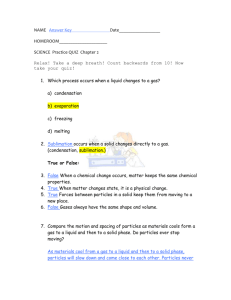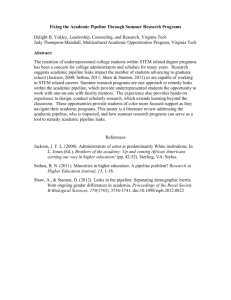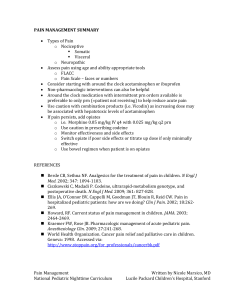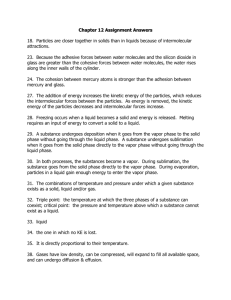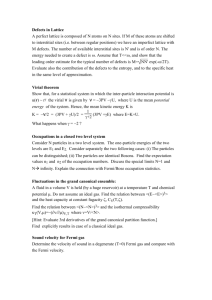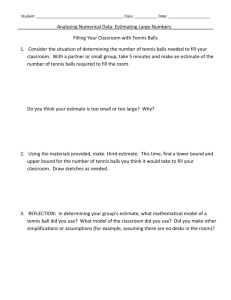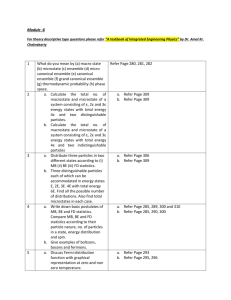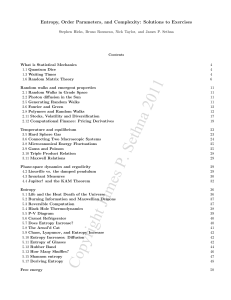Statistical Mechanics I PHY 6536
advertisement
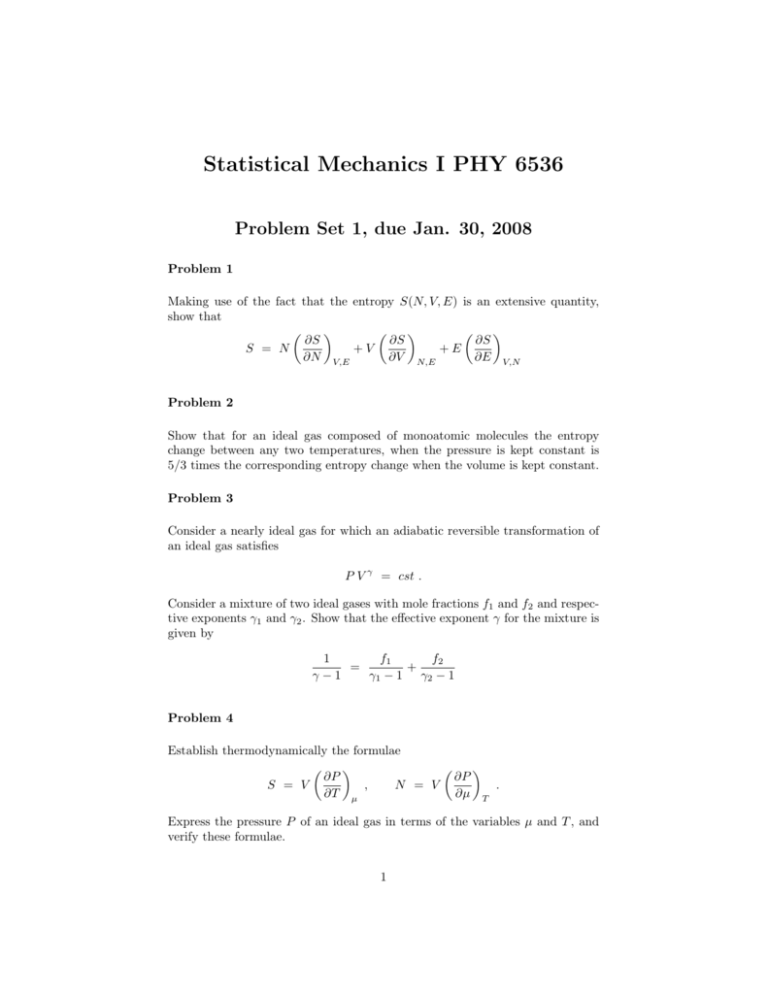
Statistical Mechanics I PHY 6536 Problem Set 1, due Jan. 30, 2008 Problem 1 Making use of the fact that the entropy S(N, V, E) is an extensive quantity, show that ∂S ∂S ∂S S = N +V +E ∂N V,E ∂V N,E ∂E V,N Problem 2 Show that for an ideal gas composed of monoatomic molecules the entropy change between any two temperatures, when the pressure is kept constant is 5/3 times the corresponding entropy change when the volume is kept constant. Problem 3 Consider a nearly ideal gas for which an adiabatic reversible transformation of an ideal gas satisfies P V γ = cst . Consider a mixture of two ideal gases with mole fractions f1 and f2 and respective exponents γ1 and γ2 . Show that the effective exponent γ for the mixture is given by 1 f1 f2 = + γ−1 γ1 − 1 γ2 − 1 Problem 4 Establish thermodynamically the formulae ∂P ∂P S = V , N = V . ∂T µ ∂µ T Express the pressure P of an ideal gas in terms of the variables µ and T , and verify these formulae. 1 Problem 5 The equation of state of a gas is found to be Np , T where a is a constant. The heat capacity at constant pressure is given by pV = N kT − a 5 N k + 2 a N f (T ) . 2 Find f (T ), and derive expressions for the heat capacity of the gas at constant volume, entropy, internal energy, chemical potential, and Gibbs potential. Cp = Problem 6 A small hole has formed in the wall of a container enclosing a volume V, containing N molecules in the gaseous state. 1-) Show that the number of molecules per unit area per unit time which leak through is given by N <v> , 4V where < v > is the average speed of the molecules. 2-) Show that the rate at which energy escapes through the hole is 2 kT . Why it is greater than the average energy of a molecule in the gas. Problem 7 Consider a system composed of a liquid and its saturated vapor in thermal equilibrium. Assuming the ideal gas equation of state for the vapor, show that the vapor pressure dependence on the temperature T is given by λM , RT where λ is the heat of vaporization, and M the molecular weight. ln p = ln p0 − 2 Problem Set 2, due February 6, 2008 Sethna: problems (1.6), (2.1),( 2.2), (2.6). You will find the following link quite useful: http://pages.physics.cornell.edu/sethna/StatMech/ComputerExercises.html Problem Set 3, due February 13, 2008 Sethna: problems (3.5),(3.8),(3.9),(3.10),(3.11). Problem Set 4, due February 20, 2008 Problem 1 Show that the phase space volume element 3N Y dqi dpi i=1 is invariant under canonical transformations. Problems 2, 3, 4: Sethna, (4.2), (5.4), (5.7) 3 Problem Set 5, due February 27, 2008 Problems 1, 2, 3, 4: Sethna, (5.13), (5.17), (6.3), (6.10) Problem Set 6, due March 5, 2008 Problems 1, 2, 3: Sethna, (7.1), (7.3), (7.4) Problem Set 7, due March 19, 2008 Problems 1, 2, 3: Sethna, (7.5), (7.6), (7.8) 4 Problem Set 8, due March 26, 2008 Problems 1, 2, 3: Sethna, (7.9), (7.11), (7.12) Problem Set 9, due April 2, 2008 Problem 1: Sethna, (7.10) Problem 2 Consider an ideal Bose gas confined to a region of area A in two dimensions. Express the number of particles in the excited states, Ne , and the number of particles in the ground state, N0 , in terms of z, T and A, and show that the system does not exhibit Bose-Einstein condensation unless T → 0. Refine your argument to show that, if the area A and the total number of particles N are held fixed and we require both Ne and N0 to be of order N , we do achieve condensation when T ∼ 1 h2 mkB l2 ln N p where l ∼ A/N is the mean interparticle distance in the system. If both A and N → ∞, keeping l fixed, then T does go to zero. Problem 3 Consider an n−dimensional Bose gas whose single particle energy spectrum is given by ∼ ps , where s > 0. Discuss the onset of B-E condensation in this system, especially its dependence on n and s. Study the thermodynamic behavior of the system and show that quite generally, P = s E , n V Cv (T → ∞) = n N kB , s 5 Cp (T → ∞) = (1 + n )N kB . s Problem Set 10, due April 9, 2008 Problem 1: Sethna, (7.16) Problem 2 Show that for an ideal Fermi gas ∂ ln z ∂T = − P 5 f5/2 (z) 2T f3/2 (z) and check that at low temperature, the adiabatic ratio γ = CP π2 ∼ 1+ CV 3 kB T F 2 , where F is the Fermi energy, defined to be the highest energy of the single particle states at zero temperature, that is Z F N = n() d , 0 where n() is the density of states at energy . Problem 3 Consider an ideal Fermi gas with energy spectrum ∼ ps , contained in a box of (hyper) volume V in n dimensions. Show that PV = s E, n f n 2 f (z) CV n n n/s+1 (z) n/s = +1 − , N kB s s fn/s (z) s fn/s−1 (z) CP − CV = N kB sCV nN kB 6 2 f(n/s)−1 (z) fn/s (z) . Problem Set 11, due April 16, 2008 Problem 1 Show that the paramagnetic susceptibility of an ideal Fermi gas can be written in the form χ = N gµ2B f1/2 (z) V kB T f3/2 (z) Problem 2 Show that the chemical potential and energy per particle of a Fermi gas at low temperature is given by π2 2 π4 4 x − x + ··· µ = F 1 − 12 80 and E 3 = F N 5 5π 2 2 π 4 4 x − x + ··· 1+ 12 16 0 respectively, where x = kB T /F . Problem 3 Derive both the low and high temperature magnetic susceptibilities of an assembly of charged massive particles of spin 3/2, to the next to leading order in the relevant variable. 7

